About Us
Vishwawalking explained
 Ratings Explained
Ratings ExplainedVishwawalks
Day walks
Food
Funky Places
Future walks
Gear
Get Lost
Good reads
Links
Right to Ramble
Site map
Contact us
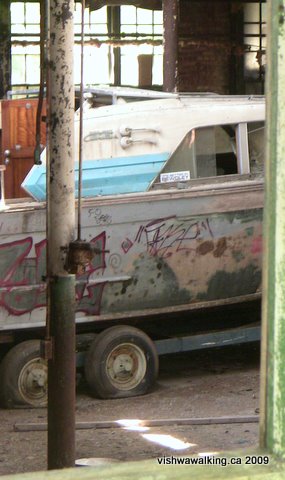
A boat sits in the space to the north. This shot was taken through the washroom window (see photo right). An old pre-50s car is just out of the photograph to the left. Second-rate graffiti artists have made a mess of the side of the boat
.
Vishwawalking
Globe File Manufacturing Company/
Nicholson File
Port Hope
The usual warning: this description is not an invitation to visit. This building is dangerous. I do not advise exploring it.For more photos click here or on any photo
Drug busts at the file factory!
Since I visited this factory, there have been two drug busts at the factory. The first was in November of 2012, and the second in February of 2014. The first drug bust in the old factory occurred 10 months after the place was bought by a Toronto lawyer (see link below). Both these events occurred sometime after my visit and I saw no evidence of this when I toured the building in 2009.
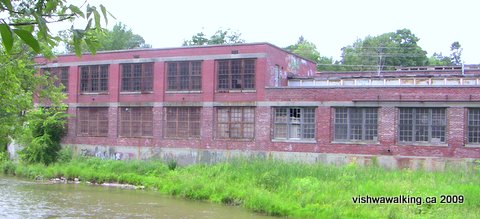 I grew
up in Port Hope. In June, 2009, while walking the Ganaraska Trail
on
the east side of the river, I passed what we used to call "the
file factory," looking pretty forlorn on the west side of the
river
on Cavan Street. After around 1975, the factory moved to a
new
and
bigger site on Highway #2, near the lake and the original factory
then
became "the old file factory."
I grew
up in Port Hope. In June, 2009, while walking the Ganaraska Trail
on
the east side of the river, I passed what we used to call "the
file factory," looking pretty forlorn on the west side of the
river
on Cavan Street. After around 1975, the factory moved to a
new
and
bigger site on Highway #2, near the lake and the original factory
then
became "the old file factory." The back of the old Globe/Nicholson file factory, looking from the east side
of the Ganaraska River.
This property sounded pretty good in the real estate listings in 2009, which indicated you could buy the place for $799,000. The two elevators described might make you think the place actually functioned. In fact, the building was in some disrepair in 2009.
The listings show the factory to be 7800 square feet. It was built in 1853. In the early 2000s the owner was an individual. I'm guessing it belonged to the municipality. In January 2012, it was sold to an individual: factory sold.
On November 24, 2008 there was a small fire in the building and in April of 2009, a nearby resident complained that a brick from the building had fallen onto the windshield of his car.
Redeveloping the file factory was a project for which the municipality considered making an infrastructure grant in 2009, but then gave other projects priority.
The Globe File Manufacturing Company operated in the building from 1888 to 1901 (This seems the most reliable date, although there are differing dates given in the few sources I could gather). I can find no occupation for the building before that, although the listings indicate it was built 25 years before. The Globe company was bought by Nicholson File around 1901.
Nicholson File originated in Providence Rhode Island. A Samuel M. Nicholson was listed as president of Nicholson File around the turn of the century.
As mentioned, the plant moved, but around 1991, the entire plant, now called Cooper Tools-Nicholson File, moved its operations to the U.S. At the time it employed just under 200 people, so it was a blow to the town.
Here's an excerpt from the Bowmanville and Cobourg Industrial Edition 1907:
"[Nicholson File] is one of the foremost institutions of its kind in Canada. The office and factory is located on Cavan street. This enterprise was originally established here some 20 years ago and has been carried on under its present title for six years. This company are manufacturers of files and rasps in different shapes and sizes. The goods are sold almost exclusively wholesale. The motive power of the factory is both steam and water. This season's output has been larger than any in the history of the firm. 125 to 150 hands are employed. The premises occupied are embraced in a number of modern buildings giving ample room accommodations for supplying the most extensive demand. Nowhere in Canada can be found such a thoroughly reliable and comprehensive stock of goods in this line. It is immense in size and variety, conveniently arranged in departments, and reflects the highest credit upon the taste and judgement of the proprietors. Without attempting to describe the same, it can be stated that it covers everything the trade, needs or uses, and merchants can here find a stock well calculated to meet all their requirements. A number of salesmen represent the house on the road and shipments are regularly made all over Canada. An export business is also done. The members of the firm are Samuel M Nicholson, President; E M Thurber, Resident Manager; Jas E Nicholson, Superintendent. They are practical business men, worthy of every trust and confidence."
Some of the dates and names above were gleaned from Some Inventory of major Canadian tool and die manufacturers, from 1820 to 1914. Some of the information clashes with the quote above. At some time, I must visit the library and look at some hard copy to do a better job of the history of this building, which is presently pretty vague.
The building today is filled with older cars, reeks of oil and other fuel and is seriously protected on the outside by large quantities of poison ivy.
As you approach from the south side, a pleasant little park fringes the river. A walk across the tidy cement remains of a factory long gone, takes you to the file factory.
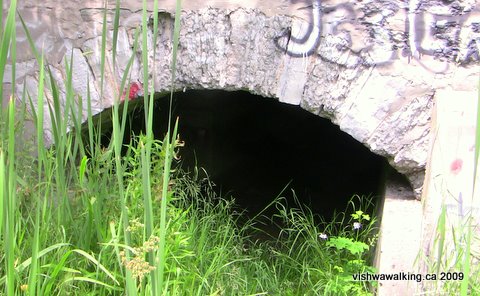 Outside and low down at the back, you can see
entrances and exits that once
received and disgorged the water needed to create the power the
factory used to run machinery. When I visited in late June, the
banks of the river had receded and it was easy to walk around the
base
of the factory.
Outside and low down at the back, you can see
entrances and exits that once
received and disgorged the water needed to create the power the
factory used to run machinery. When I visited in late June, the
banks of the river had receded and it was easy to walk around the
base
of the factory.The factory itself has an odd layout. It stretches along Cavan Street with a uniform front, with scores of windows, now broken, giving the spaces inside some natural light.
This
archway probably allowed
water to exit from the power dam the factory
had
to start up the machinery.
The same goes for the rear and south side of the building. The windows give it a Dickensian 19th-century feel. Generally, one large window is divided into six smaller window frames each of which are made up of nine little windows. That makes 54 little windows in one big window. (See the photos for a better idea of what I mean.)
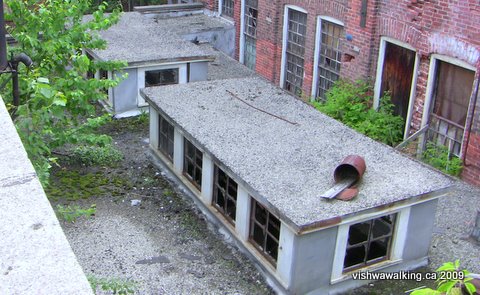 The factory, however, is not one huge
space. It's roughly made up of two floors. The surrounding factory
spaces enclose a one-story workshop in the centre of the building.
That
means that as you approach the centre from the roof of the south
side,
you come upon a drop down onto the workshop roof.
The factory, however, is not one huge
space. It's roughly made up of two floors. The surrounding factory
spaces enclose a one-story workshop in the centre of the building.
That
means that as you approach the centre from the roof of the south
side,
you come upon a drop down onto the workshop roof. The workshop has two "skylights" — large multi-windowed sections that allow light into it (see photo left) and give the lower space a more open feel.
The centre of the building is a single-story workshop with "skylights.". The larger
factory spaces surround this centre.
Despite the drab outward look of the place — one can imagine it as the site of 19th-century proletarian oppression — it actually has a generally open feel. Sitting right beside the river, looking south into the town, I began fantasizing about creating a performing/visual arts centre here. Anybody got $600,000 (I'm sure you could knock the asking price down a couple of hundred) to buy the place? Or maybe the municipality would just hand it over. Then there's the issue of two or three million to fix it up. But two elevators, eh? Come on Port Hope, go for an image of Stratford East. I'll be your artistic director for a very fair fee. [2014 update: Okay, okay, I was dreaming. The building is sold (see above).]
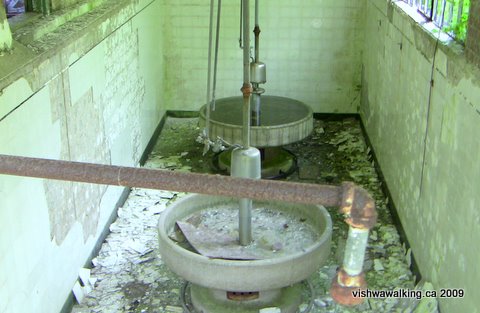 Back to reality...
Back to reality...I could not actually get into the spaces on the south and north ends, although there were plenty of windows to look down into those rooms. The main building has plenty of nooks and crannies of interest.
Inside the factory, there are all sorts of dilapidated cars sitting about. In the northernmost section of the plant, there's a dusty boat sitting in the middle of the floor, with the shell of a pre-1950s car nearby.
"She
came in through
the bathroom window..." This washroom is on the river side
of the building to the north. It was the only way I could see (from the outside looking down)
into the large storage room on the street side. The window in the upper left corner is the one
I used to get a shot of the boat in the column to the right.
of the building to the north. It was the only way I could see (from the outside looking down)
into the large storage room on the street side. The window in the upper left corner is the one
I used to get a shot of the boat in the column to the right.
At
the back of the
building, there are bits of machinery that might once have
been part of the hydro electric system: wheels and gears and
the like,
most of it in dark corners.
For more photos click here or on any photo
Back to the top of this page
Home | Contact Us | Site Map
Visited:
June 30, 2009
Page created: June 30, 2009
Updated: April 15, 2015
Page created: June 30, 2009
Updated: April 15, 2015